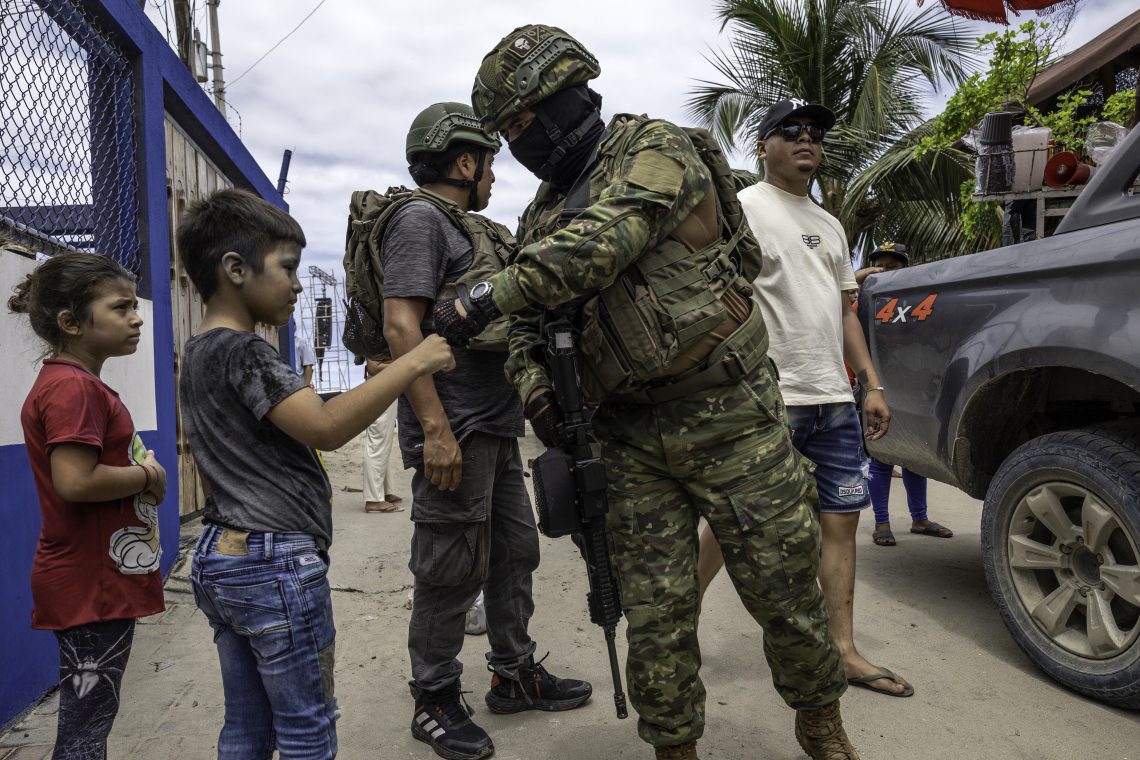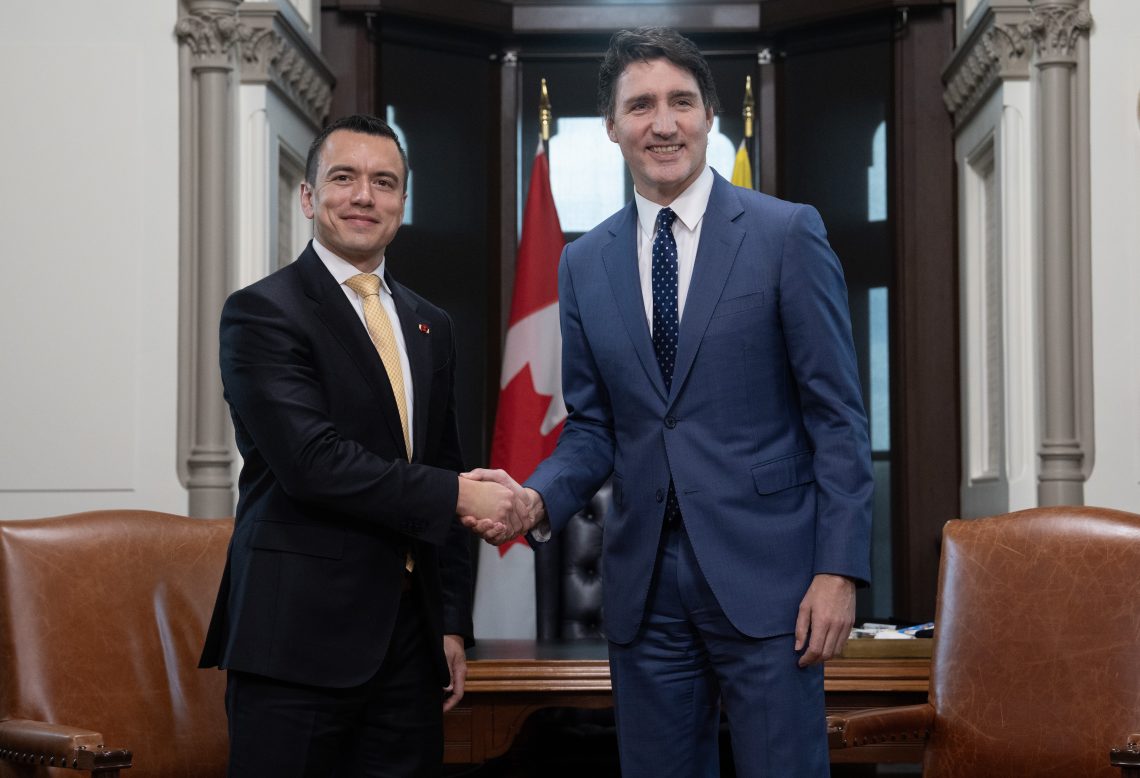Ecuador: Organized crime threatens the state
A rise in drug trafficking is destabilizing state institutions and the economy. The government is addressing the challenge with “iron fist” measures.

In a nutshell
- Ecuador’s new president has reduced the prevalence of violence in the country
- Economic viability is threatened by emigration and drug trafficking
- Long-term measures proposed, but congressional funding commitments uncertain
Ecuador’s new President Daniel Noboa is tackling an upswing in drug-related violence with swift measures to restore order and keep the economy on track. But it won’t be easy.
On January 9, masked gunmen brazenly seized control of a television station in the city of Guayaquil during a live broadcast, forcing anchors and staff to the floor and streaming the raid for 20 minutes before authorities cut the feed. Simultaneously, the country’s prisons erupted in riots as inmates took guards and workers hostage while criminal groups overran hospitals, businesses and a school. The hostage standoff in Guayaquil ended that evening when police stormed the studio and made 13 arrests, but criminal groups achieved their objective of flexing their muscle through “violent lobbying” against the state.
This chain of events had been set in motion two days earlier, when two drug kingpins escaped ahead of a prison transfer and President Noboa ordered a nationwide manhunt. He declared a 60-day state of emergency suspending citizens’ rights, imposing a nightly curfew and, due to “the existence of an internal armed conflict,” enabling the full mobilization of the country’s armed forces against organized crime. His decree listed 22 criminal groups as “terrorist organizations and non-state belligerent actors” to be targeted.
The strategy to reduce violence has worked, at least temporarily, with a spate of arrests and seizures of weapons and cash accompanying a dramatic decrease in the homicide rate. Now President Noboa seeks to make the measures permanent. Although the government’s mano dura (iron fist) proposals currently enjoy public and political support, the policy increases the possibility of civil liberties violations without addressing the structural factors behind the violence that drive gang recruitment and make organized crime attractive.
In early April, President Noboa acknowledged that there were already signs that criminal gangs were returning to violence after lying low following the initial crackdown. Long-term success will require not only time, money, domestic consensus and international cooperation, but also a commitment to cracking down on corruption and implementing judicial reforms.
Explaining Ecuador’s descent into crisis
For those who have not been following Ecuador closely, January’s news came as a shock. As recently as 2019, Ecuador was one of Latin America’s safest countries, with a homicide rate of 6.7 per 100,000 inhabitants. However, by 2023, that rate had sextupled to 45 per 100,000, with gruesome violence including police assassinations, car bombings and even bodies hanging from a bridge in the city of Duran. In August 2023, presidential candidate and anti-corruption crusader Fernando Villavicencio was killed, as were the mayor of Manta, a council member in Duran and two local election candidates.
A perfect storm of long-term factors has contributed to the rapid security deterioration.
First, while not having major homegrown guerrilla movements or significant drug production itself, Ecuador’s location, nestled between Colombia and Peru, makes it attractive to drug trafficking groups. The Colombian peace agreement and demobilization of the Revolutionary Armed Forces of Colombia (FARC) in 2017 left lucrative cocaine-trafficking routes through Ecuador up for grabs.
Facts & figures
This, in turn, attracted other criminal groups from Colombia, Mexico and even Albania, which coopted local gangs and transformed Ecuador into a narcotics hub. Now, the country’s ports of Guayaquil, Manta and Esmeraldas have become primary shipping points for exporting Latin American cocaine to Antwerp and Rotterdam in Europe and to various ports in the U.S.
Second, a fragmentation of gangs since 2020 set the stage for turf wars. The key moment was the 2020 assassination of Jorge Luis Zambrano, alias Rasquina, leader of the powerful Los Choneros gang. Subsequent competition for the group’s leadership position and its trafficking routes split Los Choneros into several parts, and encouraged allied gangs to defect, sparking a cycle of violence which played out in prisons and on the streets.
Third, presidential administrations dating back to the mid-2010s weakened judicial institutions, corruption festered and political and economic elites looked the other way in exchange for cash. The ongoing “Metastasis Case” has revealed a complex web of criminality embedded within state structures, and in 2022, 25 air force officers sabotaged radar equipment that monitored criminal gang activity in Ecuadorian airspace.
Confronting the gangs and their corruption puts one at risk: not only was presidential candidate Villavicencio assassinated, but Cesar Suarez, the prosecutor leading the investigation into the storming of the television station, was shot dead on January 17.
Lastly, limited economic opportunities for Ecuadorian youth have fed gang recruitment and violence, a problem that grew under the Covid-19 lockdowns. Low growth and a return to greater fiscal austerity since 2021 are not helping matters.
Applying mano dura
Young President Noboa – who came to office on November 23, 2023, after his predecessor dissolved the government before scheduled elections – has made addressing the country’s security situation his overriding priority. His security strategy, “Plan Fenix,” established a new intelligence unit, procured tactical weapons for security forces and reinforced security at ports and airports.
It also envisages the permanent deployment of the military to confront gangs and the hardening of prison sentences. President Noboa has announced the construction of two mega-prisons which he said would be modelled on El Salvador’s maximum-security facilities.
Facts & figures
Who is the new president?
Name: Daniel Noboa (born Nov. 30, 1987) was born in Miami to an Ecuadorian family with banana exporting and shipping businesses.
Assumed president’s office: November 23, 2023
Term: He was elected in a snap election and his term will last just 18 months before the next elections scheduled for a full term are held some time in 2025.
Previous political experience: Member of the National Assembly from Santa Elena from May 2021 to May 2023
Political views: Mr. Noboa pledged to create jobs, support free-enterprise and reduce crime and violence through justice reforms, implementing tougher criminal sentencing and anti-corruption efforts. He is an admirer of the economic policies of Argentinian President Javier Milei and supports Ukraine in its fight against Russian aggression.
To gain public buy-in for security reforms and to shore up support for his administration, the president announced a 10-question national referendum would take place on April 21. The Constitutional Court struck down some of its most controversial proposals, such as permanent deployment of the military and measures to reduce the ability to prosecute security personnel.
Still, seven of the 10 controversial questions related to security. Voters were asked whether they supported allowing the military to set up permanent roadblocks to search for weapons; increasing prison sentences; ending some early prison releases; creating a new criminal offense for the ownership of firearms reserved for use by the security forces; allowing the security forces to use weapons seized from criminals; allowing the state to use assets seized from criminals; and permitting the extradition of Ecuadorian citizens. These hardline measures had been popular with voters tired of criminality and violence and were expected to receive majority support.
Early returns on the government’s initial crackdown have been positive: between January 9 and mid-February, Ecuador’s national police arrested 7,925 people and seized 2,380 firearms.
Still, militarization exacerbates violence and leads to human rights abuses. Far from inspiring drug traffickers to lay down their weapons, militarization encourages criminals to arm themselves with deadlier, more sophisticated ones. At the same time, arbitrary detentions and arrests tend to rise as civil rights erode.
The state of emergency suspends constitutional rights, including the right to freedom of assembly, while security personnel are now – at least temporarily – authorized to enter homes without a warrant. Ultimately, without sustained efforts to address endemic poverty and corruption, mano dura measures are likely to result in only short-lived gains, and may backfire.
Ecuador’s economic outlook
The public has rallied around President Noboa, but Ecuador’s descent into internal conflict threatens the country’s stability and its economy.

The country faces a high fiscal deficit in its 2024 national budget, and so far, politicians have not been receptive to a tax increase. Credit ratings agency Standard & Poor’s has lowered Ecuador’s outlook to “negative” from “stable,” noting that the need to tackle criminal violence hampers the government’s capacity to correct fiscal policies.
There are also regional implications of Ecuador’s crisis. It is exacerbating migration, with Ecuadorians, Venezuelans and Colombians leaving the country, which weakens economic potential. Furthermore, a lack of border security could push violence into Peru and Colombia as groups fight for routes in and out of the country. Recognizing these dangers, the United States has already boosted security cooperation with Ecuador.
Scenarios
Most likely: A new normal
The most likely outcome of the government’s militarized response to criminal groups will be somewhat effective, ushering in a “new normal” where Ecuadorians choose restricted civil liberties over extreme violence, while organized criminal groups remain entrenched in politics and economics. The state’s militarized response curbs criminal groups’ willingness to operate openly and seemingly without consequence, but does not resolve underlying issues driving criminal recruitment, narcotrafficking or violence.
A fiscal problem is political unwillingness to fund the needed state response through tax increases. President Noboa plans to raise an additional $1.3 billion by increasing the value added tax rate from 12 percent to 15 percent, but his congressional allies criticized it, and the bill is likely to be rejected by legislators.
This scenario also recognizes that while hardline policies have worked elsewhere, they may be a poor fit for Ecuador. The drug traffickers President Noboa labeled as “terrorist organizations” are motivated by money and are financed by the international drug trade; negotiations will be an uphill battle. Equally importantly, the government’s militarization of the conflict lacks an exit strategy, and there is no indication of a long-term plan.
Somewhat likely: Worsening security crisis hurts the economy
The next most likely outcome is that militarization of the “internal conflict” causes violence to spike, as it did in Mexico in 2006 after President Felipe Calderon militarized his country’s conflict. In that case, security forces themselves were corrupted and criminal groups fought back with still more deadly violence against the state. This could happen in Ecuador if criminal groups believe their livelihoods are truly threatened.
That would lead to a weaker state and an increase in violence, as in Colombia in the 1990s, leading desperate state security forces to commit not just civil rights violations, but human rights abuses in response. A worsening of the crisis would be devastating for Ecuador by hurting industry, reducing tourism, increasing migration and raising the cost of business in the country.
Least likely: A return to the 2010s
The least likely scenario is government success in capturing and imprisoning criminal leaders, managing its prisons, snuffing out violence and bringing the country back to the high-growth and low-violence era of the early 2010s. To achieve this, President Noboa would have to develop a long-term security plan ensuring that judges and lawyers are not beholden to criminal organizations while politicians and others are held accountable, with a viable exit strategy.
Such a plan would also have to rebuild the feeble anti-narcotics units, strengthen cooperation with both the U.S. and Ecuador’s Andean neighbors and bolster the state’s presence along its borders and in its ports. This scenario, however, is also predicated on President Noboa gaining reelection in 2025 and holding his coalition together.
Success is not impossible, but decades of the War on Drugs have not reduced cocaine production in neighboring Colombia and Peru nor dampened foreign demand. Consequently, positive developments are more likely to be incremental rather than total. Financing investments in education, employment and economic growth will be a challenge for the president.
For industry-specific scenarios and bespoke geopolitical intelligence, contact us and we will provide you with more information about our advisory services.










